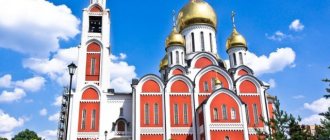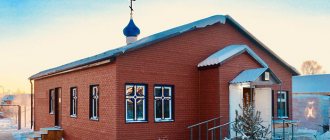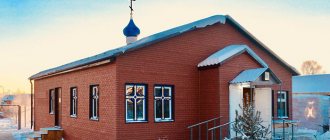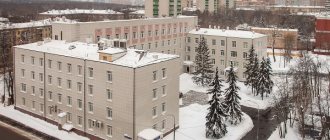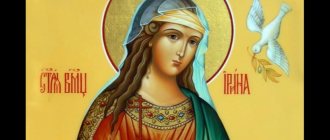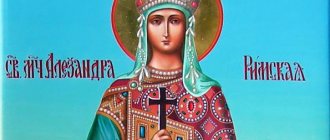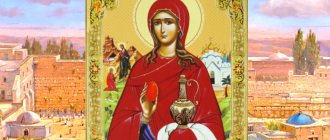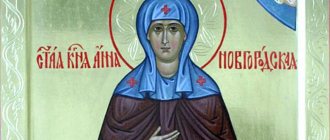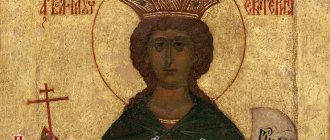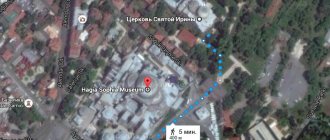When seriously studying icons, you quickly realize that you should not confuse the lives of the saints glorified in Eastern Orthodoxy with real history. Although the percentage of fact and fiction varies from saint to saint, some are completely fictitious.
The icon of the saint that we will discuss today is one of the most outstanding, and was known not only in Russia, but throughout the pre-Protestant Christian world - St. George the Victorious.
Life
Childhood and youth
He was born into a Christian family in Cappadocia at the end of the 3rd century. At an early age he was left without a father. Being a faithful Christian, he died as a martyr. The mother took her son to her homeland in the city of Lydda (modern name - Lod, Israel).
Interesting fact
It was in this city that George was later buried. Currently, the saint’s tomb is located under the Orthodox church built in his honor. Some of the remains of the great martyr and the chain that he was wearing in prison before his death are kept there. It is believed that it cures mental illness.
From childhood, his mother instilled in the boy a love for Jesus Christ, helped him get a good education and left a rich inheritance.
Military service
George entered military service, where Emperor Diocletian drew the attention of the brave young man. Already at the age of 20, the young man received the honorary title of commander over a thousand warriors.
Arrest
Being a pagan, the emperor intensified the fight against Christians (this fact is known in history as the “Great Persecution”, the last and most severe persecution of believers in Jesus in the Roman Empire in the early 4th century). Georgy could not stay away. He gives away all his property, frees his slaves and reveals his faith to the emperor, which means certain death for the saint. Diocletian called on him to renounce Jesus, but when he refused, he ordered his arrest and torture.
Torture and wheeling
When the guards took him to prison, their spears began to bend and break as soon as they touched the body of the condemned man. The emperor became even more angry and ordered his former warrior to be wheeled on the wheel. He was tied to a wheel. At the bottom they installed boards with sharp iron tips, which tormented the prisoner’s body as they rotated. Despite the severe torment, George prayed to the Lord and thanked him. And when everyone thought that the saint was dead, an Angel appeared and healed him.
Useful materials
The pagans who witnessed the miracle believed, but the emperor only became even more angry. The brutal torment of the prisoner lasted 8 days. He was covered with quicklime, tortured with a hot iron, beaten and even forced to drink poison. But nothing worked. The Lord saved his devoted follower every time, and even helped him resurrect the dead.
Execution
On the eve of the execution of the martyr. The Lord visited George, calmed him down and laid a crown on him. The next day the saint's head was cut off.
Along with the great martyr, the emperor's wife Alexandra was also executed. The miracles that happened to the prisoner inspired her to renounce paganism, for which she was punished by her husband.
On the Day of Heroes of the Fatherland, we remember the image of St. George the Victorious, one of the most beloved saints of the entire Christian world, who is reflected in many works of church and secular art and has undergone many changes over the centuries.
The image of St. George the Victorious, one of the most beloved saints of the entire Christian world, is reflected in many works of church and secular art and has undergone many changes over the centuries.
Despite all the popularity of George, his real existence has long been called into question. Even in ancient times, he was often confused with other holy warriors - Dmitry of Thessalonica, Theodore Tyrone, Theodore Stratilates, who lived at the same time. His name, meaning “farmer” in Greek, is similar to one of the epithets of Zeus (Georgos), and to the name of the Thracian horse-god (Heros), from which the word “hero” itself comes. George is connected with many threads with pagan mythology, or more precisely, with the cult of the serpent-fighting god - the conqueror of monsters and protector of people. Perhaps this is what allowed him to become so famous: such different countries as England and Greece, Georgia and Russia consider him their patron.
Saint in three persons
The lives of the saint say that George was the son of a military leader from Cappadocia, who after the death of his father moved to his mother’s hometown - Lydda in Palestine (now Lod, Israel). There, a young man distinguished by strength and courage joined the Roman army, achieved a high position and became the favorite of Emperor Diocletian. When he began persecuting Christians, George, devoted to the teachings of Christ since childhood, appeared in Nicomedia (now the Turkish city of Izmit), where he declared himself a Christian before the emperor himself. Diocletian, in anger, ordered him to be tortured: the martyr was beaten with whips, poisoned, thrown into a pit with lime, wheeled, but each time, by the grace of God, he remained alive and unharmed. Eventually his head was cut off with a sword. This happened on April 23, 303. Seeing his perseverance, many residents of the city accepted Christianity, including the emperor’s wife Alexandra; her bloodthirsty tyrant also ordered her execution, after which the fire that descended from the sky incinerated him. True, all this does not fit with historical facts, according to which Diocletian died much later by natural causes, as did his wife Prisca. To overcome the situation, in some lives the mythical Persian king Dacian was made the saint’s persecutor.
The beheading of Saint George. Hood. Altichiero da Zevio. Fresco. Around 1380. Chapel of San Giorgio in Padua
Martyrdom of St. George. Hood. Michiel van Coxie. 1588
Be that as it may, already in the 4th century the cult of George was established in Syria and Palestine, where in Lydda believers worshiped the tomb of the saint (it has survived to this day and belongs to the Jerusalem Orthodox Church). On the earliest icons he was represented as a martyr - in a white tunic and red robe, with a cross in his hand, without weapons or armor. This reflected the evidence from life that he left army service before visiting the emperor. But time passed, Christians from the outcasts became the elite of the Roman Empire, including the military, and they needed their heavenly patrons, and George was perfectly suited for this role. Since the 8th century, he began to be depicted in armor, with a spear or sword, and all sorts of feats were attributed to him.
Tomb of the Holy Great Martyr George the Victorious. City of Lod, Israel
One of these feats was the “Miracle of the Serpent,” known in many versions. According to them, one day George learned that the lands of a certain pagan king were being devastated by a terrible dragon. This was either in Berit (Beirut), or in Syrian Laodicea, or in Palestinian Ebal or Libyan Silene. The dragon “closed” the water sources from the townspeople, forcing them every month by lot to give him a young man or a girl to be devoured. When this fate befell the king’s daughter (in the East she was called Elisava, in the West - Sabra), George was just passing by and saw the maiden, “beating her breasts and tormenting her hair.” After praying to God, he waited for the dragon to appear and pierced him with a spear. Later, this story was supplemented: the hero at first only wounded the monster, tied him with a girl’s belt (which, as is known, deprives dragons, unicorns and other monsters of the strength), took him to the city and killed him there with a sword, prompting all the inhabitants, led by the king, to convert to Christianity.
Saint George. Sculptor Donatello. 1415–1417
This legend made George the heavenly patron of knights going on the Crusades. After King Richard the Lionheart saw the saint in shining armor ahead of his army, he made the red St. George's Cross on a white field the symbol of England. In the 13th century, the “Miracle of the Serpent” was included in the most popular “Golden Legend” of Jacob of Voraginsky. At the same time, on the wall of a cave temple in the Crimean Eski-Kermen, an image of a saint in three faces appeared: just a horseman, a horseman slaying a dragon, and a horseman with a boy behind his back. The latter refers to the story of young Manuel, whom, according to the lives, George saved from robbers. Moreover, it is stated there that this feat, like snake fighting and many others, was accomplished by the holy warrior posthumously, appearing to people in the flesh according to the will of God.
Saints George and Theodore killing the serpent. Fresco in a cave temple. XI-XII centuries. Türkiye, Cappadocia
The paintings of the Temple of the Three Horsemen reflect the three hypostases of George: protector, dragon slayer and savior. In fact, there were much more of them: he was considered the patron saint not only of warriors, but also of farmers and cattle breeders. In Bulgaria they prayed to him for the sending of rain, in Greece - for the offspring of livestock, in England - for deliverance from poisonous snakes. In Georgia, the image of White George (Tetri Giorgi) is placed on the state emblem; he is also revered here as a relative of the country’s baptizer, Saint Nino. In neighboring Ossetia, he merged with the ancient thunder god in the form of Uastirdzhi - a mighty old man on a white three-legged horse, a mediator between God and people. George (Jirjis) is also considered an immortal helper of people in the Islamic world.
In Rus', two whole holidays are dedicated to George (aka Yuri and Yegor). On the spring Yury's day, April 23 according to the Julian calendar (according to the new style, May 6 is celebrated), the cattle are driven out of the barn to the fields, and on the autumn day, November 26 (December 9), winter begins and “Yegory releases the wolves.” The second date is associated with the consecration in the beginning. 1050s St. George Church in Kyiv, erected by the famous Yaroslav the Wise (baptized George). Princes, clergy and people revered the saint in different ways, which also affected the interpretation of his image.
Headless horseman
Back in the 6th century, George became the patron saint of the Byzantine emperors, and on frescoes and mosaics he was depicted just like them - in gilded armor, with a spear in one hand and a shield in the other. A characteristic detail was a red cloak - a symbol of martyrdom, which was also reminiscent of the crown on the curly hair of the saint, always represented as young and blooming. Sometimes images of George appeared on the imperial throne with a sword in his hand, as well as paired images with Saint Demetrius of Thessalonica or Theodore Stratelates. In the 10th century, against the backdrop of constant attacks on Byzantium by Turkic nomads, its main military force became not infantry, as before, but light cavalry - stratiots. Then, remembering the “Miracle of the Serpent,” they placed the beloved saint on the horse: in motion, with a cloak flying behind his back and a proudly raised spear, George looked much more impressive than before.
Holy Great Martyr George the Victorious. Icon. XIII century. Byzantium
Holy Great Martyr George the Victorious. Icon. XIII century. Byzantium
In the 9th century, the first images of this miracle appeared in the cave temples of Cappadocia. Icons at that time more often depicted the life cycle of the saint: around the central face or figure there were stamps with scenes from his life - from the confession of faith before Diocletian to the beheading. Then the posthumous miracles of George began to appear in the hallmarks, and even later the “Miracle of the Serpent” came to the fore and was written on separate icons. Several types of them are known: in some, the equestrian hero easily hits the monster with a spear, in others, entire scenes are presented with the princess, the townspeople and their king, looking at the battle from the wall. In 15th-century Balkan icons, the king hands the winner the keys to the city, symbolizing his and his subjects’ acceptance of the new faith. The princess is depicted in a prayer pose (legends say that she was the first of the townspeople to believe and later became a nun). The whole scene is reminiscent of the ancient myth of Perseus and Andromeda, to which, most likely, the “Miracle of the Serpent” dates back.
Saint George. Hood. Jacopo Tintoretto. 1543–1544
Saint George. Hood. Jacopo Tintoretto. 1543–1544
If in Cappadocia, where the military elite of the empire came from, George was more often depicted as a snake fighter, then in Constantinople, the capital, he was still seen as a proudly standing warrior, the patron of imperial power. He also had another role - the defender of Christ and the Mother of God, as in the triptych at the end of the X - mid. 11th century ivory, where George and other holy warriors surround the luxurious throne of the Savior. By the 15th century, there was a return to the early practice of the bust-length depiction of George in the image of Diasorite, that is, the savior of the princess. Soon the Turks took Constantinople, the empire fell, but its art continued to develop for some time in the distant provinces. For example, in Crete, where a new type of image of the Victorious emerged - Kephalophoros, with his own severed head in his hands. This was reminiscent of the suffering of Christians under the rule of infidels, and the image of St. George the Serpent Fighter (now often hidden in folding icons) called for struggle. A characteristic feature of this time: the dragon wraps its tail around the horse’s legs, as if holding the hero captive. Only a few centuries later the Orthodox Greeks became free, and George remains their favorite saint today.
Arbaville triptych. End X - mid. XI century. Byzantium. St. George the Victorious - on the right wing at the top left
Such different Georgies
In Western Europe, George was revered already in the 8th century, when a relic appeared in the Roman basilica of San Giorgio in Velabro - the head of the saint (“alternative” heads, however, are kept in a dozen other cities). His images for a long time repeated Byzantine models and only with the beginning of the Renaissance did they acquire a “special character.” One of the first to turn to the “Miracle of the Serpent” was the Florentine Paolo Uccello in the 15th century, in whose painting you can see all the elements of the future Western “Georgiana”. A noble knight on a mighty horse strikes a terrible dragon with a spear, from whose wound blood flows. The mouth of the cave on the left and the spinning vortex on the right represent the violent forces of nature - George, a real mythological hero, is called upon to tame it, along with the monster. In contrast, the princess looks serene, having already tied the dragon with her belt (which is why stabbing him in the eye with a spear looks somehow unknightly).
Saint George and the dragon. Hood. Paolo Uccello. Around 1470
The great Raphael turned to the image of George several times. In one of his early works (“Little Saint George”), the young hero, having broken a spear on a dragon, finishes it off with a sword; in a later one, created around 1506, he canonically wields a spear while his mighty horse tramples the monster with its hooves. Almost at the same time, the Venetian Vittore Carpaccio created two paintings on this topic. The first is dedicated to the battle: a determined knight rushes towards the enemy against the backdrop of a bizarre landscape, across which the bones of dragon victims are horribly scattered. The second plot is “The Triumph of St. George,” where the winner, surrounded by a bright oriental crowd, kills the embarrassed, defeated monster with a sword. Also unusual is a painting by another Venetian, Jacopo Tintoretto, painted in the 1540s and kept in the Hermitage (it was previously considered the work of the artist’s students, but recent restoration has revealed touches characteristic only of him). In this canvas, the characters are extremely close: leaning on the horse’s neck, Georgy plunges a spear into a strange alien dragon in front of the frightened princess. Returning to the plot a decade later, Tintoretto turned the angle: now his hero is finishing off a dragon somewhere in the depths, in front of them lies a man killed by a monster, and in the foreground the princess is running away.
But if the Italian painters, having moved far away from the iconographic canons, retained the symbolism of the plot, then the masters of the Northern Renaissance took a different path. With them, George acquired the same rough objectivity as his opponent. This is no longer a youth, but a mature man, muscular and even fierce, as on the right side of the altarpiece by Jost Haller (circa 1445). The apotheosis of this tradition was the enormous painting by Peter Paul Rubens, completed in 1608. In it, a powerful god-like hero riding an even more powerful horse slays a wounded, but still terrible dragon with a sword in front of a middle-aged, plump princess.
Triumph of St. George. Hood. Vittore Carpaccio. 1502–1507
At the same time, the tradition of the “ceremonial portrait” developed, where George proudly poses against the backdrop of the monster he slain, which he sometimes feels sorry for. As, for example, in the painting by an unknown artist of the Frankfurt school (circa 1480), in which the hero tramples a small dragon, more like a tapir, with smart red shoes. Standing apart is the painting by the master of landscapes Albrecht Altdorfer (1510), where against the backdrop of a grandiose, carefully painted forest, little George is almost lost, striking not a dragon, but a toad with wings. The artist reasoned that both were incarnations of the devil, with whom the pious knight fought.
Saint George slaying the dragon (Little Saint George). Hood. Raphael. 1503–1505
Saint George and the Dragon. Hood. Peter Paul Rubens. 1606–1608
In modern times, the subjects of medieval legends were forgotten, until in the 19th century they were resurrected by romantically minded painters, including the English Pre-Raphaelites. Their leader, Dante Gabriel Rossetti, created a painting in 1857 with an unexpected subject - “The Wedding of St. George and Princess Sabra.” Here George, presented in the Christian tradition as a virgin, becomes a happy newlywed, bringing the bride a valuable gift - a box with a dragon's head. In 1889, the painting “Saint George and the Dragon” was created by the Frenchman Gustave Moreau, who returned to the classical interpretation: a young hero, a terrible dragon, streams of blood. Only the crafty snake-like princess looks unusual, praying either for the salvation of the dragon slayer or for his death.
Wedding of St. George and Princess Sabra. Hood. Dante Gabriel Rossetti. 1857
Many variations of the image of George were created by sculptors - from Michel Colombe, who lived in the 15th–16th centuries, with his truly frightening dragon, whose size emphasizes the hero’s feat, to Salvador Dali, who sculpted a completely traditional (albeit with an empty egg-face) holy warrior. Our contemporary Zurab Tsereteli also turned to this image more than once: in front of the UN headquarters in New York, his George chops atomic missiles into pieces, and on Poklonnaya Hill in Moscow - a dragon, nicknamed by wits “Krakow sausage”. By the way, the city of Krakow, according to Polish legend, received its name from the hero Krak, who killed the terrible dragon - tsmok. This once again reminds us that the theme of dragon fighting is immense and St. George remains only one of its personifications, albeit the most famous.
Return of the Wyrmfighter
Russian iconography of St. George is as extensive as Western iconography, but less varied. The masters of Ancient Rus' did not emphasize the hero’s courage and fighting spirit, and did not depict the bloody details of the battle with the dragon. Yes, this was not the case in the Russian legend “The Miracle of the Serpent,” where the enemy was defeated not with weapons, but with prayer: “And by the power of God, the great martyr and passion-bearer of Christ George fell under the knees of his feet, the terrible serpent.” Icon painters emphasized that George enters battle not for the sake of glory or honor, but for the sake of victory over evil, which embodies the dragon, or rather the serpent, as they said in Rus'. At the same time, art critic Mikhail Alpatov Fr.
Small state seal of Ivan the Terrible. 1539
The first images of the saint, repeating Byzantine models, date back to the 11th century: the frescoes were preserved in the St. George's chapel of St. Sophia of Kyiv. Under Yaroslav the Wise, George was depicted on princely coins and seals. The “miracle of the serpent” became widespread in Rus' in the 12th century, and gradually new details began to appear on the icons: a city with a crowded crowd, a king looking at the dragon fight from the city wall, an angel placing a martyr’s crown on the head of a warrior. Strict rules for depicting a popular plot were drawn up: “The miracle of St. George, how to deliver the maiden from the serpent, is written as follows: the holy martyr George sits on a white horse, having a spear in his hand and with it he stabbed the serpent in the larynx; and the serpent came out of the lake, great and terrible; The lake is great, next to the lake there is a mountain, and in another country there is a mountain, and on the edge of the lake stands a maiden, the royal daughter, wearing a royal robe of great magnanimity, holding a serpent with a belt and leading the serpent with a belt into the city...” A complete composition of the icon appeared (with the princess, city, angel and crowd of people) and the more common shortened one (only with George and the serpent).
The unification of Rus' under the rule of the Moscow Grand Dukes made the image of George even more popular. From the end of the 14th century, he adorned their seals, although at that time he was simply called “rider,” that is, a horseman. In 1464, Ivan III decorated the Frolovsky (now Spassky) gates of the Kremlin with a white stone sculpture of George the Serpent Fighter. This image of a horseman defeating a dragon began to be perceived as the coat of arms of Moscow, and soon after the appearance of a new state symbol - the double-headed eagle - it settled in the shield on the chest of the bird. True, scientists believe that the rider of that time, deprived of a halo, represented not a saint, but a king, but the king himself, Peter I, did not agree with this, and by a special decree declared the rider on the coat of arms to be Saint George. During the reform of Russian heraldry in the middle. In the 19th century, the rider was turned to the left (heraldic right) side. During Soviet times, this image was forgotten, but in 1993 it returned to the coats of arms of Russia and Moscow. By the way, this is related to the correction of an error: in the empire, George’s opponent was called a dragon, but in heraldry he is a “good” symbol. Now it has been officially renamed the serpent - a symbol of “bad”.
The St. George tradition is so deeply rooted in Russian culture that it attracts even seemingly alien elements. An example is the famous Bronze Horseman, created by Etienne Maurice Falconet, a Frenchman, Catholic, and admirer of the ideas of the Enlightenment. Catherine II (who had just established the Order of St. George) did not approve of the snake under the feet of Peter’s horse, but the sculptor insisted on his own and created the most important image of the new state mythology, where the first Russian emperor, like the Serpent Fighter, acts as a “cultural hero” and a fighter against chaos .
New interpretations of this theme are already associated with the era of modernism. In 1885, the painting “St. George the Victorious” was created by Valentin Serov. His hero, a fragile young man in a golden helmet, strikes the dragon with a long red lightning spear that goes high into the sky. So the artist emphasizes that only higher powers helped George win. The image of this saint was also important for the founder of Russian abstract art, Wassily Kandinsky. Perhaps it was in honor of him that the artist named the association he created in 1911 “Blue Rider”. At the same time, the painting “Saint George II” was painted, where in the confusion of color spots one can discern a hero in something like a carnival mask, who strikes with a spear a dragon outlined only by a jagged line. On the left you can see Elisava in a blue cape, hurrying away. In 1915–1916, Kandinsky created another, more traditional painting on this theme, where a warrior rushing towards the enemy, a dragon peeking out from a cave, and a proud princess in an ancient Russian dress are clearly visible.
Another Russian avant-garde artist, Pavel Filonov, also turned to this subject. In his “mosaic” painting (1915), a young warrior looks calmly and detachedly at a multi-colored dragon lying at his feet. The almost human face of the monster is full of sadness, and George feels sorry for him, as does the hero’s white horse standing next to him. The entire space of the picture revolves around them: a horseman with a pipe, houses, dogs, Elisava crying in the left corner. The artist replaces the pathos of the fight against evil with the theme of unification and humanization of all living beings, which is close to him.
Untitled (St. George the Victorious). Hood. Pavel Filonov. 1915
In the Soviet era and after it, the heroic hypostasis of George, his role as a defender of his native land, again came to the fore. In his image, artists represent military leaders, most often Marshal Zhukov (symbolically, George). Without a doubt, the tradition of depicting the holy fighter against evil will inspire art masters for a long time, regardless of whether George actually lived or came to us from the eternal space of myth.
What to read?
Vilinbakhov G.V., Vilinbakhova T.B. Saint George the Victorious. - St. Petersburg, 1995.
Reginskaya N.V. St. George the Victorious is the heavenly patron of Russia in the fine arts of Europe and Russia. - St. Petersburg, 2010.
The meaning of the image of a saint
On icons, Saint George is most often depicted as a young warrior in armor.
St. St. George the Victorious
- The most famous list: a young man with a spear riding a white horse kills a snake. It is based on the legend of the saint’s miracle performed after his death.
- The young man is depicted from the waist up. In one hand there is a spear, in the other there is a shield or sword.
- The martyr sits on a horse and holds the reins in his hands.
- The saint is depicted up to the neck. The head is tilted to the right.
- George is on a horse, and behind him is a boy.
How does prayer to the image of the Great Martyr help?
What do they pray for in front of the icon? The story goes that those who defend the Motherland ask St. George the Victorious for help. People often pray to the saint on the eve of battles. He is considered a patron saint for military personnel and those in combat zones. Protects from enemies.
- It is believed that St. George the Victorious patronized Marshal Zhukov and appeared on the battlefield. It is curious that Germany officially proposed to sign the act of surrender on May 6, 1945 (on the day of the celebration of the great martyr).
- In addition, farmers and cattle breeders pray to him (for rain, for the harvest and for good luck in the hunt).
- The saint can strengthen those who are disappointed in life in their faith, give them fortitude and courage.
- Georgy also helps resolve conflicts in families.
- Heals the sick.
- Helps childless families.
- Supports defenseless people.
- In some countries, the saint is asked for deliverance from infectious diseases.
- He helps travelers on the road.
When is the day of veneration of St. George celebrated?
In Christian churches, celebrations in honor of the Reverend are celebrated several times a year:
- December 9 (according to the old style, November 26) - the Russian Christian Church, at the behest of Prince Yaroslav the Wise (baptismal name George), began to celebrate as a memory of the consecration of the Kyiv Cathedral by the Great Martyr on this day;
- November 23 (November 10, old style) - this day Georgia celebrates the venerable wheeling;
- November 16 (old style November 2) - a memory of the cathedral in Lydda, renovated in the 4th century, named after the Saint;
- May 6 (old style April 23).
Miracle with the Serpent
According to an ancient legend, a huge winged serpent lived on a lake near the city of Beirut (Syria). He looked like a dragon and kidnapped people. No one could cope with the monster.
The frightened locals, who were pagans, decided to take turns donating their children to the monster. The turn came for the king’s daughter. She was tied to a tree near the lake. Soon a dragon appeared from the water. At the same time, a horseman appeared on the shore. He saved the princess by piercing the snake with a spear. Later, a healing spring appeared at this place. A temple was built there in honor of the Great Martyr George. It was he who saved the residents of Beirut from the dragon, after which they massively adopted the Christian faith (more than 25 thousand people).
Holy Great Martyr with a Spear
In Rus', Saint George was known for a long time; they began to glorify him already in the first years after the adoption of Christianity. In the 11th century, a church was built in Kyiv in his honor. Temples of St. George the Victorious also appeared in Novgorod and Vladimir.
The plot of George with the serpent in Rus' has been known since the 12th century (fresco of the Church of the Great Martyr in Staraya Ladoga).
Most of the oldest icons, those of Novgorod, depict only a horseman, a snake and the Lord blessing the saint.
Since the end of the 15th century, artists have added to the plot an angel crowning a saint, a princess leading a defeated serpent, or a saved city. Sometimes the usual movement of the knight from left to right changes to the opposite. And on some shrines the horse is depicted not as white, but as black or brown.
Description and ancient interpretation of the victory over the monster
- symbol of the victory of Christianity, deliverance from paganism;
- a symbol of victory over evil, over sin, over the devil;
- symbol of military courage;
- a symbol of the victory of Russian troops over their enemies;
It turns out that the saint not only saves the princess from death, but also the entire pagan people from spiritual death. Gradually, the plot of St. George defeating the serpent begins to be considered a military symbol.
St. St. George the Victorious
It can be found on coins and seals. In addition, it became the official coat of arms of Moscow and part of the coat of arms of Russia. For the first time, a horseman killing a snake became a symbol of the Moscow principality after the victory in the Battle of Kulikovo.
9
May
1994
A memorial church was founded in honor of the Victory in the Great Patriotic War next to the memorial on Poklonnaya Hill. Construction was carried out using city funds.
Prayer to St. George the Victorious from enemies visible and invisible
First prayer
O all-validated, holy great martyr and wonderworker George! Look upon us with your quick help, and beg God, the Lover of Mankind, not to judge us, sinners, according to our iniquities, but to deal with us according to His great mercy. Do not despise our prayer, but ask us from Christ our God a quiet and godly life, mental and physical health, fertility of the earth, and abundance in everything, and may we not turn the good things given to us by you from the All-Bountiful God into evil, but into the glory of the Holy One in His name and in glorification of your strong intercession, may He grant our country and all the God-loving army victory over the adversaries and strengthen us with unchangeable peace and blessing.
May His angel protect us saints with a militia, so that we, upon our departure from this life, may be delivered from the wiles of the evil one and his difficult airy ordeals, and may present ourselves uncondemned to the Throne of the Lord of Glory. Hear us, passion-bearing George of Christ, and pray for us unceasingly to the Trinitarian Lord of all God, so that by His grace and love for mankind, with your help and intercession we may find mercy, with the angels and archangels and all the saints at the right hand of the Just Judge of the world, and He will be glorified with the Father and Holy Spirit, now and ever, and unto ages of ages. Amen.
Second prayer
Holy, glorious and all-praised Great Martyr George! Gathered in your temple and before your holy icon, worshiping people, we pray to you, known to the desires of our intercessor, pray with us and for us, beseeching God from His mercy, may He mercifully hear us asking for His goodness, and not abandon all ours to salvation and life needful petitions, and grants our country victory in the face of resistance; and again, falling down, we pray to you, victorious saint: strengthen the Orthodox army in battle with the grace given to you, destroy the forces of the rising enemies, so that they will be ashamed and put to shame, and let their insolence be crushed, and let them know that we have Divine help, and to everyone in sorrow and the current situation, show your powerful intercession. Pray to the Lord God, the Creator of all creation, to deliver us from eternal torment, so that we glorify the Father, and the Son, and the Holy Spirit, and we confess your intercession now, and ever, and unto the ages of ages. Amen.
